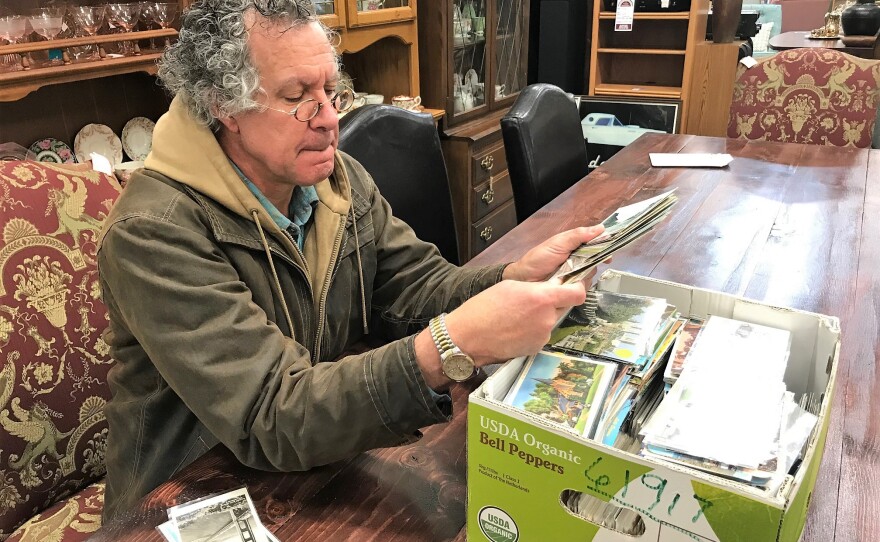When John Meissner strolled into Greeley antique shop Lincoln Park Emporium recently, it didn't take long for a display of postcards near the counter to catch his eye.
"These are amazing because you never — see this is like, new 'old' stock," Meissner said, flipping through the rack. "So they're perfect."
The cards, placed next to some boxes of candy, depict a variety of Colorado tourist spots. They're all from Denver's Sanborn Souvenir Company. The cost? 25 cents apiece.
"Which is a very fair price and it just shows you, postcards right now are tough to sell," Meissner said.
But not all of them. These are from Bill Sanborn, shot in the 1960s and '70s. A postcard by his father, Harold Sanborn, can be worth $100 or $200 depending on the rarity, according to Meissner, who collects the postcards.
Not much is known about Harold Sanborn. There aren't even any photos of him — an oddity for a man who spent his life behind a camera. The closest Meissner can find is a photo of Sanborn's wife and children.
"They're up in Wyoming and they look very unhappy as if, we're on vacation, we're in a vacation spot, but we're still working," Meissner said of the photo.

Sanborn started the Sanborn Souvenir Company out of downtown Denver in the 1920s. For the next 40 years, the commercial photographer traveled throughout Colorado and Wyoming, taking pictures of local places of note, anything he thought might make a marketable postcard.
Now Meissner goes from town to town, scouring antique shops and flea markets for Sanborn's work.
As he geared up to go through one of the store's boxes containing more than a thousand postcards, Meissner admitted that the task can be a bit like looking for a needle in the proverbial haystack.
"When you go to a postcard show where a room this size would be filled with only dealers selling postcards, it just becomes physically difficult after a couple hours to go through each and every postcard," he said.
Most of the time, he comes up empty-handed.
But there is a map. Thanks to careful notes still kept by the current owner of the Sanborn Souvenir Company — no relation to Harold — Meissner knows that over his career Sanborn shot more than 10,000 different views for his " real photo postcards."
"We know how many he produced, but we don't know the views," he said. "So we don't know if we're going to see something — that may be a small business, it may be the interior of a restaurant in a small Colorado community like Crawford or Rye, Colorado, that may be the only photograph that was ever taken of that."
And photos from those communities might be some of the most rare. Sometimes Sanborn would only print 25 postcards of an image. If it didn't sell well, he wouldn't print more.

Because Sanborn had such a large inventory of images, he included a code — along with his signature — on the front of each card. The codes divided up Colorado into geographic regions: D for Denver, I for Idaho Springs, G for Grand Lake.
Sanborn's artistic merit is debatable, Meissner admitted. To prevent his photos from appearing dated — and keep them commercially viable — Sanborn took photos without people or vehicles in them.
"The problem is they look somewhat lifeless and somewhat flat," he said.
But that's not what Meissner — and many other collectors throughout Colorado and the country — are interested in. It's the connection to local history.
"He made an attempt to go into every town and city in Colorado and Wyoming and take their civic buildings, their churches, their courthouses, their post offices," Meissner said. "But also their smaller businesses — their restaurants, their cottage courts, their gas stations."
Which is why Meissner helped found the Estes Park Archives, a group of "armchair archaeologists" working to curate a collection of memorabilia from the town's past — everything from photographs to phone books.
Since Sanborn shot a large percentage of his work there, his postcards have become a focal point for the group.
"Yes, it might be something common," Meissner said. "Yes, it might be Longs Peak, and we have plenty of pictures of Longs Peak. But it may be a business that existed in the Big Thompson Canyon or it may be a cottage that was in Glen Haven that, this is the only picture we're ever going to have of it."
But after 10 years of searching around the country, they've only found 60 percent of Sanborn's postcards from the Estes Park area.

Now they are reaching out to the community for help.
"We spread the word, we let people know, here's what we're interested in," Meissner said. "If you've got postcards, even if they're not Sanborns, we're very interested in looking at them."
The group is an active buyer of Sanborn postcards. They've spent into the six figures obtaining the collection so far, Meissner said. Eventually they'll sell the duplicates and create a book on the postcards, along with a digital archive so that anyone can see the postcards online.
But even if people don't want to sell their postcards to the group, Meissner said he's interested in seeing them. Because for him, it's not just about collecting postcards. It's about alerting people to a part of history that might be sitting boxed up in someone's attic before it heads to the junkyard and possibly disappears forever.
Meissner said he hopes to inspire other "citizen historians" like himself.
"I think that benefits everyone," he said. "I think the more that we learn and the more that we share, the more that we understand our past, which helps us kind of understand where we're going."







